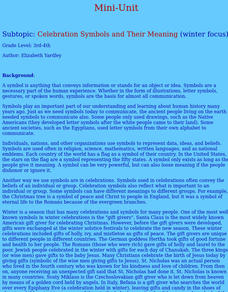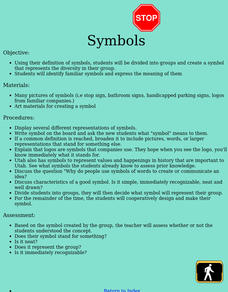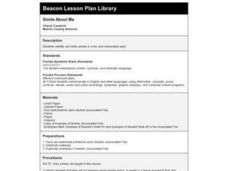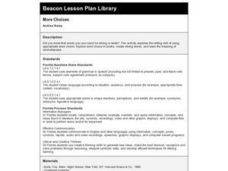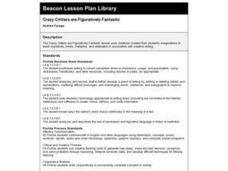Curated OER
The Adventures of Tom Sawyer Questions
For this reading comprehension worksheet, students respond to 5 short answer questions about themes from Twain's The Adventures of Tom Sawyer.
Curated OER
My Candle
This is probably my students' favorite writing assignment. They obviously tell their friends about it, because every year my ne
Curated OER
Celebration Symbols and Their Meaning
Students develop a symbol that represents something they wish to celebrate or include in a celebration of their choosing.
Curated OER
Symbols
Students, using their definition of symbols, divide into groups and create a symbol that represents the diversity in their group. They identify familiar symbols and express the meaning of them.
Curated OER
Animals in Ancient Rome (Grades 1-5)
Students invent, illustrate, and describe hybrid exotic animals, their imaginary origins, and lifestyles. They explain the ways in which ancient Romans made use of various animals.
Curated OER
Good Will - Three Chinese Stories
Young scholars listen to The Seven Chinese Brothers and identify tall tale elements in it. They brainstorm ways they could help each other in school. They create a banner reflecting the style and art of Chinese decorations and clothing...
Curated OER
Figurative Language: simile
In this simile activity, students fill in the blanks to similes about themselves. Students complete 6 similes total on this activity.
Curated OER
Imagery
Students read the poem The Worker by Richard W. Thomas as an example of the effective use of imagery. Then they complete a 5-senses chart describing some part of nature, e.g. sea, clouds, etc. Then they write their own poem using the...
Curated OER
Native American and Colonial Literature Debate
High schoolers compare the tone, purpose, point of view, etc. of traditional Native American poems and creation myths to traditional Colonial American literature. they debate which is the right way of thinking/living.
Curated OER
Simile About Me
Learners are introduced to similes and read various examples. Then students write their own similes to describe themselves and share them with the rest of the class.
Curated OER
More Choices
Fourth graders create onomatopoeia for a variety of things such as a mean dog, a crying baby or a doorbell ringing after exploring word choice as used by authors in selected books. They complete a Word Choice worksheet that is attached.
Curated OER
Mighty Metaphors
Fourth graders explore metaphors and then complete a worksheet on which they write metaphors. They may illustrate the metaphors.
Curated OER
Getting to Know My Apple
First graders compare an apple to unlike things in a simile poem. ie: The apple tastes sour like a lemon. When poems are complete, have students share their simile poems with the class and finish eating their apples.
Curated OER
Crazy Critters are Figuratively Fantastic
Eighth graders use creatures created from their imaginations to practice hyperbole, simile, metaphor, and alliteration in association with creative writing. They utilize a worksheet imbedded in this plan to guide their writing.
Curated OER
Three ways into the play 'Stone Cold'
Tenth graders, in groups, write pieces of a script in a particular style that they are introduced to. They also study how tension and irony work together in scripts.
Curated OER
Macbeth
High schoolers examine patterns of imagery in Macbeth by using online resources. Students compare the patterns they see to those they've found in other Shakespeare plays. Then high schoolers draw conclusions about why Shakespeare might...
Curated OER
A Midsummer Night's Dream
Students examine patterns of imagery in A Midsummer Night's Dream by using online resources. Students compare the patterns they see to those they've found in other Shakespeare plays. Then students draw conclusions about why Shakespeare...
Curated OER
Othello
Learners examine patterns of imagery in Othello by using online resources. Students compare the patterns they see to those they've found in other Shakespeare plays. Then learners draw conclusions about why Shakespeare might have used the...
Curated OER
Merchant of Venice
High schoolers examine patterns of imagery in Merchant of Venice by using online resources. Students compare the patterns they see to those they've found in other Shakespeare plays. Then high schoolers draw conclusions about why...
Curated OER
Original Line or Familiar Find?
Students examine a primary source document from 1684 that includes many of the same lines found in Romeo's speech to Juliet from Shakespeare's Romeo and Juliet. Students compare the texts and discuss authorship during the sixteenth and...
Curated OER
Figurative Language Alive: Balcony Scene Charades
Students act out lines from Romeo and Juliet in a charade-like game.
Curated OER
Visual Arts Lesson: Writing desk
Sixth graders examine a writing desk. They each make decorative drawers to scale for assembly into a class desk. They use repetitive motifs in their designs.
Curated OER
An Anecdote is Worth a Thousand Pictures
Pupils identify anecdotes in speeches and the purposes that politicians use the anecdotes for. They create personal anecdotes for the class to hear, and students decide if the anecdote is real or fabricated.
Curated OER
"How to Eat a Poem"
Eighth graders write a poem showing what they know about metaphors, and non-literal language to express ideas, convey meaning, and create images after they read Eve Merriam's "How to Eat a Poem".
Other popular searches
- Teaching Literary Devices
- Literary Devices and Terms
- Literary Devices & Quotes
- Common Literary Devices
- Literary Devices and Reading
- Introducing Literary Devices
- Literary Devices Irony
- Glossary of Literary Devices
- Literary Devices Inkheart
- Literary Devices Music
- Literary Device Flashback
- Ell Literary Device Activity




